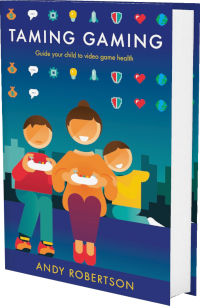 Android
Android iOS
iOS Mac
Mac Switch
Switch Wii
Wii Wii U
Wii U PC
PC PS4
PS4 PS5
PS5 Xbox One
Xbox One Xbox X|S
Xbox X|S07/12/2023 4 months ago Author: Andy Robertson
Super Mario Bros. Wonder is a new game from Nintendo that introduces parent-like talking flowers that react to the player. It’s a lovely touch, that runs against the usual separation of child-like and grown-up play. As I’ve played through the game with these companions bringing parent-like punctuation to the action, it’s made me wonder why video games are considered a pursuit for childhood, and why play is seen as superfluous to adulthood.
I know this sounds like a nonsensical question. It comes from spending (too much?) time talking to game journalists and playworker friends. Playworkers have taught me that play is crucial for a healthy childhood. Game journalists testify to play as fundamental to a vibrant adulthood. Both sets of friends understand and are passionate about play, but are unaware of this overlap.
As I played Super Mario Bros. Wonder, the talking flowers were an unexpected expression of this overlap. Before digging into the whys and wherefores of these peculiar talking flowers, let's think about the similarities and differences of these two groups. While playwork is laser-focused on ensuring sufficient play for children, video game journalists seek language that values adult game-playing. They are both defenders of the value of play for its own sake. They both have something of value to offer the other.
The impulse to play is innate, a biological, psychological and social necessity.
Playwork Principles are a set of values that aim to ensure access and opportunities for un-instrumentalised children’s play. They are focused on children, of course, but take them seriously and they impact more than how we run play spaces for youngsters. They offer a framework for recovering the importance of play for all of life, adult life included. How about this from the first principle, “the impulse to play is innate, a biological, psychological and social necessity.” If this is true surely this extends beyond childhood into all of life.
Video game journalists, if they are anything, are people who put themselves on the side of play. Just listen to video game podcasts like The Back Page, The Besties or My Perfect Console waxing lyrical about a thousand precious playful moments video games have created. These shows are not unsurprisingly created for people who play games already, but the rich play experiences on the table have clearly grown far beyond a juvenile pastime.
This overlap is something that has informed my work with video games for some time. I’ve had the chance to talk with playworkers about what digital play could look like. I’ve been present as adults first held a controller, or helped a playworker take tentative steps into video games. I’ve experimented with applying playwork principles to the use of video games in PSHE lessons. I’ve found many of the most misunderstood video game topics become clearer and understandable when set beside the history of playwork and junk playgrounds.
Throughout these projects and conversations, the benefit of the collision of these two very different worlds comes down to two things:
- The Playwork movement offers a framework that can underpin a repositioning and reinterpretation of the place of video games in society.
- Video game play offers a way to understand play as something that extends beyond childhood in ways that aren’t restricted to competitive sports.
Koichi Hayashida, one of the game’s developers, told Eurogamer that the team “spent about six months seriously developing live commentary.. adding voices to match the player's actions”. We don’t know the motivation, but this move mirrors how streamers narrate their play and how we make broadcast sport more interesting to adults by overlaying a detailed commentary.
As the game evolved the commentary idea morphed into occasional talking flowers sprinkled through the levels. Now, as you play you are accompanied by the occasional adult commentator. Many of the flowers say no more than “Heyyyy”, “Heya” or “Hiii!”. But then, as you progress the flowers’ commentary turns into gentle encouragement. "Onward and upward!", "How'd you get up here?!", "That trunk sure is useful, huh?", "Doing great!" and so on.
This kind of careful interjection was familiar to me from spending time with playworkers (although of course, the relationships between playworkers and children go far beyond words of encouragement). These adults work with children not to control or direct play, but to defend and aid access to it. The flowers, like playworkers, are there to support play rather than to have agency of their own. They exist to hold the space, support play and offer observations of what’s happening right now and what has happened previously. The flowers encourage young players to be ambitious, saying things like "Doing great!", "You've got it!" or "Go for it!". They also offer subtle suggestions of how the play might progress, "Timing is key...", "That trunk sure is useful, huh?", "Don't let 'em see you!".
You see this most clearly on the challenge levels where players are stretched to their limits. The risk is different to that of a child jumping from a height or attempting a new stunt in a physical playspace. The outcome isn’t that they may injure themselves. Here the risk that they hit a virtual wall and decide to stop playing.
Like a playworker in a physical playground, the flowers are an unusual type of adult. Unusual because they are on the side of play.
In these moments, the work of the flowers becomes more involved and nuanced - not unlike a playworker balancing their commitment to play and the potential of a child to misunderstand a particular risk and hurt themselves. This might be as simple as "Deep breaths..." or “Focus, take a breath”, “Always believed in you”. Then as the stakes are raised the flowers offer more direct advice, “Try it with another player.” “Will you go up the left or the right?” “All-right, this way.” Sometimes they even highlight some potential dangers to ensure the player has noticed them, “That’s a lot of piranha plants.”
Like a playworker in a physical playground, the flowers are an unusual type of adult. Unusual because they are on the side of play. They make the game welcoming to new players. They ensure players who may be struggling give it all they have before giving up. They even offer subtle hints without the player feeling like they’ve had to ask for help.
Not unsurprisingly, the flowers could learn a thing or two from the longstanding experts in supporting play: playworkers. Playworkers could help find a tone that was supportive without being patronising (as the flowers sometimes are). They could highlight the importance of avoiding overpraising. Or the importance of knowing the play context and the player rather than generic phrases (AI flowers in Super Mario Bros. Wonder 2 maybe?).
They could also highlight the importance of spaces where children can play beyond the adult gaze. Maybe some levels without flowers and options to misbehave (finding cheats maybe, breaking the level or playing in some unintended way) when the flowers aren’t watching? They could have highlighted the importance of not offering too much direction or intervention. “I wouldn’t hang out here, if I were you,” a flower says at one point, which feels over-protective, particularly when followed by the “I warned ya!”
My imagined conversation between playworkers and game developers excites me not only for capitalising on Playwork Principles in virtual spaces but for what playworkers might discover. The video game world is full to bursting with adults who understand the importance of play and have held onto it in spite of the prevailing assumption that it’s something to grow out of.
This conversation, this collision, has the capacity to clear space for video games at the heart of society and culture.
This conversation, this collision, has the capacity to clear space for video games at the heart of society and culture. It’s not something that those of us who know and love video games have managed, perhaps because we all too quickly miss what’s playful by being distracted by what’s pretty. But with the eye of the playworker turned to video games we can start to champion these overlooked play-frames, as they would describe them.
It’s a possible future where it will make as little sense to say “do you play games” as it would be to ask “do you read books” or “do you listen to music”? Of course we do, the question is what shall we play?
 | Andy Robertson |
© 2024 Family Gaming Database














